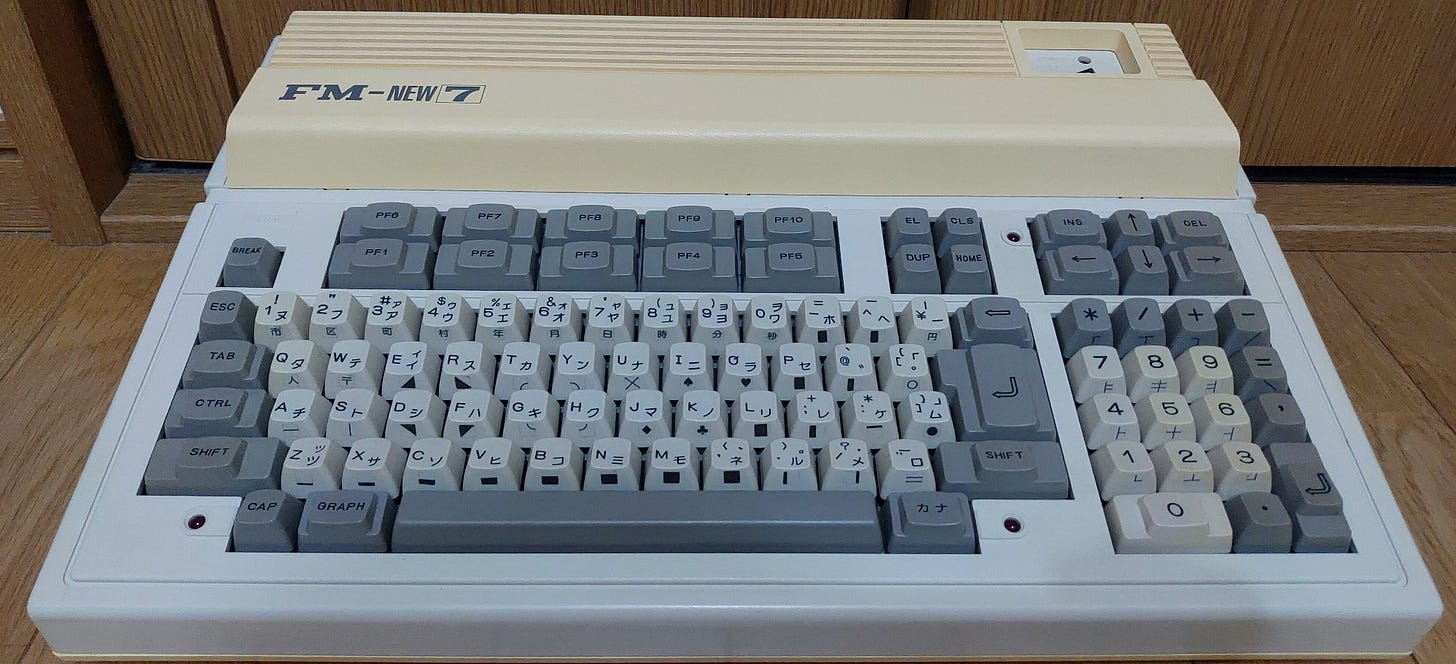So, I was looking for a particular game, which will be mentioned in a future post. Then, I stumbled upon a photo, but some of the text was blurry. I thought to myself “is that the game’s source code, and I can I recreate it?!” It was all written in BASIC (Beginners’ All-purpose Symbolic Instruction Code) a programming language for the average person who uses computers. This video game was made for the Fujitsu FM-7, a microcomputer made by Fujitsu, before FM-Towns & FM-Towns Marty. Unfortunately, very little documentation and online tutorials are available online. Manuals are written in Japanese and Spanish, so I had to switch back & forth on the instructions.
Like the Commodore 64 or Texas Instruments TI-99A, the FM-7 has its own version of BASIC called Fujitsu Disk Basic or F-BASIC for short. F-BASIC is based on the Tandy TRS-80’s BASIC. Unfortunately, I do not have an FM-7, they are next to impossible to find in a working condition. Luckily, I have an emulator called XM-7. The keyboard layout is a bit different to the QWERTY format. Meaning, they symbols and shapes on said keyboard. So, trying to figure out where the symbols like the colon (:) or the at symbol (@) frustrated me the most. Since I am one of the small number of Americans who can get this emulator to work, I am taking it upon myself to get these programs & utilities preserved.

Because the emulator’s instructions are scarce, it took me a good while to figure out where the symbols are at. This is important because some BASIC games actually require these symbols. After figuring that out, it’s time to start practicing recreating some games, and there are resources to choose from. For now, I chose a game from a magazine called プログラムポシェット (Program Pochette), issue 12.
I was reading the source codes, until I came across this simple game
So, I went with Poloof, some kind of soccer game that I probably messed up on. Needless to say, I was pretty excited that I finally got a game to run!
I learned a lot over the weekend, at the cost of my sleep. :(
I’m going above & beyond to help preserve these games. The FM-7 library is lacking games, and this will help greatly expand the library now that I got this figured out. Some of these games are saved in cassette tapes or 5.25 in floppy disks. While some of them still work, they will not last forever, that explains why I was learning this programming language. I have experience with different programming languages like Python, C+, Javascript and HTML. So I was able to pick up on this very quickly. Unfortunately, I do not know what any of these lines mean, but I will figure it out as learn more about BASIC.
I have more work to do, especially with this custom-made BASIC utility called PF-X. It is compatible with the FM-7 and NEC’s PC-8801 series of computers. I’ll write a separate post once I get this game called Box Ten to work. Here are the photos of my progress and the source code.
I’ll keep logging my progress, and share what I learned. For this blog, I learned how to save files on virtual tape and floppy disk images (Single, 360k and double-density, 720k). Load files from the virtual cassette & disk, execute said programs. Then, I learned how to get a game I recreated from the source code provided.







